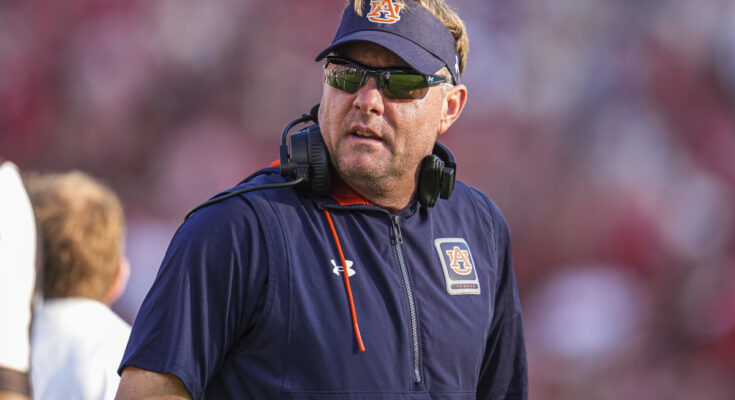Teeing Off at the Wrong Time: Major College Football Coach Criticized for Golfing During Recruiting Lull
The head coach of a major college football program is under intense scrutiny this week after reports surfaced that he spent part of a critical recruiting period on the golf course. The optics are bad, the timing is worse, and fans—already restless after a series of underwhelming recruiting classes—are growing louder in their frustration. While it’s not unusual for coaches to enjoy downtime during the offseason, this situation struck a nerve because it came amid a stretch where the program has been falling behind on the recruiting trail. With commitments rolling in for rival schools and recruiting rankings painting a bleak picture, the news of the coach golfing felt to many like a tone-deaf misstep at best—or outright negligence at worst.
Sources close to the program confirmed that the coach played at a private course during a recent recruiting window, a time when many of his SEC and Big Ten counterparts were flying cross-country to visit prospects, host unofficial visits, and secure commitments. In college football, recruiting is never truly off the clock. The top programs treat every open period with urgency. That urgency has often defined the difference between average and elite, between a rebuilding year and a championship run. For a coach to take what appears to be a leisurely break during such a crucial stretch has ignited questions about priorities, commitment, and the overall direction of the program.
Fans and alumni took to message boards and social media to voice their frustration. Screenshots of tee times, social media posts of the coach on the course, and even speculative threads about who he was golfing with began to circulate. Some speculated whether it was simply a brief mental health break, while others accused him of coasting on a bloated contract with little regard for performance. One high-profile booster, who asked not to be named, said bluntly: “You can’t be on the green when we’re not getting players. Not now. Not with this momentum—or lack of it.” The frustration isn’t just about one round of golf. It’s a symbol. It’s a culmination of multiple recruiting cycles that have seen this once-proud program fall behind its peers in both blue-chip signings and national buzz. The coach, once seen as a program savior, is now drawing fire for seeming detached.
This isn’t a first-time issue either. For the past two offseasons, critics have pointed to the coach’s inconsistent presence on the recruiting trail. While other programs were closing deals with top-100 players, this staff was sometimes late to offer, slow to follow up, or unable to get key targets on campus. Recruits talk, and their families talk too. Word gets around quickly when a coach doesn’t show up or doesn’t follow through. Add in a few seasons of middling on-field results, and you’ve got a storm brewing. The optics of being seen golfing while the team drops in the recruiting rankings gave that storm the lightning strike it needed to erupt.
Former players have started weighing in as well. Several took to social media to express concern over the current state of the program. One former standout tweeted, “We built this place on sweat, grind, and 365 recruiting. No off days. No golf days. Not in July.” That message, while not naming the coach directly, was widely interpreted as a public rebuke. Another former player, now in the NFL, told a reporter, “The place looks soft now. And soft doesn’t win in this league.” In a sport where perception matters almost as much as performance, being labeled soft or disconnected can be the kiss of death for a head coach.
Administrators inside the university are said to be monitoring the situation closely. While no public statements have been made, insiders suggest that pressure is mounting behind the scenes. It’s no secret that in today’s landscape of college football—with NIL, the transfer portal, and high-profile coaching salaries—the leash is shorter than ever. Boosters want results. Donors want returns. Athletic directors want headlines that show progress, not indifference. A coach who appears to be checked out during recruiting season could find himself on the hot seat faster than expected, especially if the team struggles in the early part of the season.
To be fair, it’s possible that the coach’s golfing trip was scheduled well in advance. Maybe it was a charity event or a long-standing personal tradition. Maybe it lasted only a few hours and didn’t conflict directly with any scheduled recruiting visits. Maybe some of this outrage is performative. But in the high-stakes world of college football, perception often beats reality. The timing couldn’t have been worse, and the critics are using this incident as a proxy battle for deeper concerns about the program’s trajectory. Some fans have started to call for a leadership change, arguing that energy and urgency are lacking at the top. Others are taking a wait-and-see approach, hoping that a strong fall camp and early-season wins will cool things down.
Recruiting analysts have been noting the program’s downward trend for months. Despite having strong facilities, a loyal fanbase, and a tradition of success, the program has failed to crack the top 15 in recruiting rankings in consecutive years. Meanwhile, regional rivals are landing five-star talent and reshaping their rosters through both traditional recruiting and portal acquisitions. Momentum is everything in this sport. The perception that the program is standing still—or worse, slipping—while others accelerate is dangerous. It impacts not just this year’s class, but future cycles, donor confidence, and even TV negotiations.
There are real consequences to falling behind in recruiting. Depth becomes an issue. Star talent becomes scarce. Games are harder to win. Rebuilding takes longer. Coaching staffs get reshuffled. Fans tune out. And suddenly, the narrative around a program shifts from “building something special” to “wondering what went wrong.” The coach, whether he meant to or not, has added fuel to that narrative. Whether he can change it will depend not on apologies or explanations but on results—both on the field and on the trail.
Internally, there’s still support for the coach among some key figures. Players reportedly still respond well to him. Many believe he’s a good culture fit and a stabilizing presence. But the question remains: is stability enough in today’s cutthroat environment? Is being liked and respected by players enough when recruiting is slipping and wins are elusive? The golf outing, fairly or unfairly, has become the rallying cry for those who believe this staff lacks urgency. It’s become a symbol of complacency at a time when energy and grind are needed more than ever.
In the days following the initial backlash, the coach has not publicly commented on the situation. That silence has created a vacuum that critics are happy to fill. Some say he’s tuning out the noise, while others say he’s simply not reading the room. One media personality, during a national radio segment, said, “You’ve got to at least show your fans you care. Even if you didn’t do anything wrong, say something. Show them you know what time it is. Show them it’s recruiting time—not tee time.” That quote has been shared widely, often alongside images of the coach smiling on the course. It’s not a good look.
Whether this controversy will have long-term consequences is yet to be determined. If the coach rallies the team to a 10-win season and closes strong in recruiting, all will be forgiven. If the program struggles, this golf story will be remembered as the moment it all started to unravel. Coaches live in glass houses these days. Every move is watched, every off-field activity dissected. In the NIL era, where recruiting is more transactional and competitive than ever, even a few hours off the clock can look like negligence. Fans want to believe their coach is outworking everyone. When they see him golfing while others are grinding, it breaks that belief.
Ultimately, this isn’t just about golf. It’s about perception, momentum, and leadership. It’s about a program at a crossroads, and a coach whose actions—however innocent they may seem—have given his critics an easy target. This is college football in 2025. Every tweet, every photo, every missed opportunity counts. The stakes are too high, and the margin for error is razor-thin. The question now is simple: how will he respond? Because if he doesn’t, someone else will.



